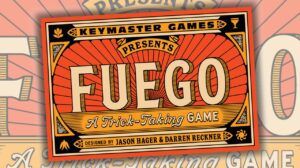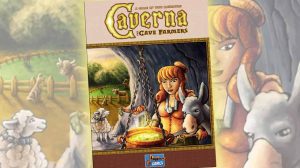Push Push Penguin – Justin Bell
The conceit behind Push Push Penguin (2025, Wacky Wizard Games) is a cute one—penguins are pushing each other down a slippery slope into the ocean, with fun illustrations by Christopher Ryan Chan that look like a cross between the penguins from ICECOOL and a slightly more sinister twist on the animal-themed images I’m used to in many other games. That sinister bit is because Push Push Penguin has an interesting win condition: whoever gets to the ocean and gets “surprised” by an orca token first is the first loser…and the next player in line behind that player wins the game.
Push Push Penguin was designed by Chan, David Gordon, and TAM; the latter two have designed a few games over the last couple years, including LEGO house favorite Monkey Palace. That means Push Push Penguin is very family friendly, with quick rules and a playtime that is so short my 11-year-old openly wondered if the game was actually too short. The initial stages of Push Push Penguin are all set up, as players quickly move down an icy slope on the board towards the ocean before trying to slow themselves down with a dice mechanic that allows players to pick the higher or lower of a two-die roll to move forwards.
The game’s finish is more interesting, but we found even on our first play that we had seen all Push Push Penguin had to offer as players use the game’s push process—land on another player’s space, and that pushes them one space forward—to ensure they can be in second while pushing the lead player to their doom. The stranger mechanic is a weird one: the lead player can save themselves by rolling a certain symbol on a D6, but that pushes them to the back of the pack, essentially guaranteeing that they will not get a chance to win. I think my kids are just a hair too old to revisit a game like Push Push Penguin, but I would happily play it again with friends who have a 4- or 5-year-old hungry for penguin action. (Just don’t tell them what really happens when the orca shows up!)
Ease of entry?
★★★★★ – No sweat
Would I play it again?
★★★☆☆ – Wouldn’t suggest it, but would happily play it (with younger kids!)
Read more articles from Justin Bell.
Resurgence – Kevin Brantley
Sometimes you’re scrolling through social media and stumble across a game that makes you think, “Hey, I’ve never seen or heard of that—I need to know more!” Enter Resurgence: a post-apocalyptic Moscow setting with worker placement and bag-building in a Eurogame? Now I’m extremely interested.
From the light cartoon art style to the chunky wooden tokens and subtle pastel accents, the game has a nice table presence while still maintaining a small footprint on the shelf.
In typical worker placement fashion, players draw different worker types from their bag to place on the board, rebuilding their faction and headquarters. There are base-level workers, specialists, and a single leader token that acts as a wild. Workers can be placed in locations to accumulate resources, complete missions, and recruit survivors who grant powers and passive income. Also lurking on the board are mutants who drive up the cost of visiting certain spots. Players can construct new rooms on their player board to unlock stronger actions. At the end of each round, they gain income from completed missions and have the chance to level up their headquarters.
Overall, it was a nice time visiting the wasteland of Moscow. The survivor cards teed up some combos, and the puzzle of finding the right resource at the right moment was satisfying. Interaction is limited but present—section majority tracks can shift, and in the second half of the game, locations become pricier as the board fills with pieces.
There are some mildly interesting systems at play, though none of them fully land. The bag-building reminded me of Orléans (an all-time favorite), while the base-building evoked This War of Mine (but far less punishing). Event cards can also spice things up, sometimes offering bonus scoring opportunities, other times forcing someone to sideline a worker—like the time one player had to keep their leader out for an entire round.
Still, the game lacks variety outside of event and survivor cards, and interaction often feels muted. Even when another player took my intended spot, it only cost me a small handful of resources to carry on. My engine always felt satisfying, but the game was missing that “I just need one more turn” spark that stronger Euros deliver.
Resurgence has plenty for worker placement fans, and its production and theming are top-notch. Unfortunately, it doesn’t quite reach the full potential of its stride.
Ease of entry?:
★★★★☆ – The odd bump or two
Would I play it again?:
★★★☆☆ – Wouldn’t suggest it, but would happily play it
Read more articles from Kevin Brantley.
San Juan – K. David Ladage
The game Puerto Rico is one of those beautiful designs that is plagued with colonialism. Not too terribly long ago, I acquired a copy of the new edition which goes a long way toward addressing those issues (thanks, Steve!). But in all the time I have enjoyed the game, I have not had the chance to try San Juan.
While attending the latest session of Congress of Gamers, my friend Mike pulled this game out and asked my wife and I to play. I was surprised by the smooth gameplay and the straight-forward nature of the game. I knew where I wanted to go, and I even knew what I needed to do to get there. Performing those actions was not always in the cards, as it were, based on what roles were going to be performed before and after your action… in other words, it was a Puerto Rico experience distilled down to a rather fast paced card game. Love it!
Ease of entry?
★★★★★ – No sweat
Would I play it again?
★★★★★ – Will definitely play it again
Read more articles from K. David Ladage.
Wordsy – Justin Bell
Gil Hova’s 2017 design Wordsy has an upcoming redesign courtesy of the team at Allplay. After picking up a review copy of the new version at Gen Con a few weeks ago, I can confirm what one of our Meeple Mountain colleagues thinks about Wordsy as well: it’s a very quick, fun word game that is a great fit for anyone who loves games like Scrabble and Bananagrams, mixed with newer fare like Daryl Chow’s Alphabeasts Attack! that push on player creativity to form words and max out scores under the pressure of an hourglass resting nearby.
Wordsy is played across seven turns. Using a mix of eight letters in a grid available to all players, Wordsy is a race against a short 30-second clock—once any player has thought up a word that uses at least one of the eight letters in the grid, the timer is flipped and all other players get 30 seconds to come up with a word that is then written on a personal tracking sheet and scored, with each used letter from the grid counting for 2-5 points. Like Alphabeasts Attack!, players will form words using only some of the letters pictured, so getting creative is a key to victory. Bonus points are awarded to the player who triggered the timer as well as the player who came up with the brawniest scoring word.
After players drop their lowest two scoring words, players add up the scores for their remaining five words as well as bonus points to determine the winner. My wife and eight-year-old son tried Wordsy after dinner recently and had a blast coming up with words, especially when some of the harder letters hit the table. The new version’s calligraphy is a little confusing, but each letter card also has the letter in more plain print—albeit a bit tiny—tucked into the left-hand corner. The game could also use player screens to help players hide the words they came up with, but that wasn’t a problem in my family play even if I think it would be an issue with more competitive players.
Ease of entry?
★★★★★ – No sweat
Would I play it again?
★★★★☆ – Would like to play it again
Read more articles from Justin Bell.
The Chameleon – K. David Ladage
My recent trip to Congress of Gamers was fruitful in the fact that I did get to play some games that were new to me. One of which was a game of The Chameleon. This is a game that reverses the methodology of games like Apples to Apples or Dixit. Players are dealt a decoding key – except one person did not get the key, they got the card that tells them that they are the chameleon this round. With the roll of two dice, players then use their key to look at a card with words on it. The key tells them which word on that card is the code word for the round.
With play passing clockwise from the dealer, each player then states a word that lets the other players know that they know the selected word. The chameleon has to improvise! They will listen to the words any players previous to them have said and try to suss out the word so that they can give an answer to fool the group into thinking they are not the chameleon. If they are going first, this is brutal and almost impossible; if they are going last, they have a lot of info to work with. Like Dixit, the idea is to be vague enough to not give it away, and specific enough to let the other players know who you are. For the chameleon, is it about listening, acting like you are checking the key, and if you are early in the round, being vague enough to apply to any of the words on the card. Once everyone has answered, the players all vote on who they think the chameleon is. Some points are awarded depending upon the result..
In the end, the game is interesting, but lacks meat on the bones. I cannot put my finger on what is missing, but it just seemed a bit too straight forward for what it was going for.
Ease of entry?
★★★★☆ – The odd bump or two
Would I play it again?
★★★☆☆ – Wouldn’t suggest it, but would happily play it
Read more articles from K. David Ladage.
















